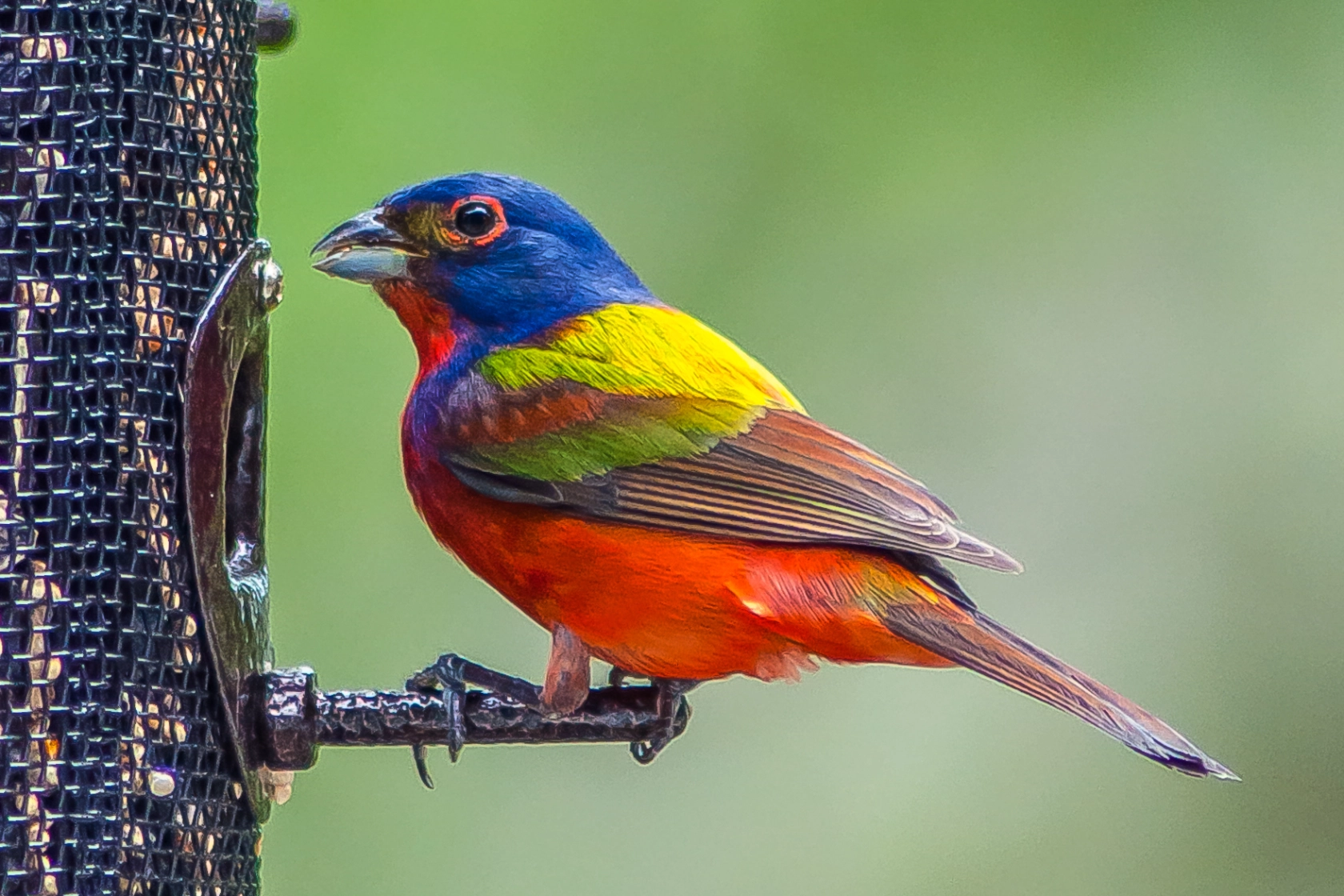Virginia experiences an influx of yellow birds during the spring and summer when warblers arrive. However, in the winter months, the American Goldfinch and Yellow-rumped Warbler become the commonly sighted yellow birds in this region.
To assist in the identification of yellow birds spotted in Virginia, this guide provides pictures, identification information, song recordings, and migration patterns.
The majority of yellow birds found in Virginia are warblers, orioles, or tanagers, and occasionally, female birds of these species exhibit distinct appearances from their male counterparts.
With the comprehensive information provided in this guide, identifying yellow birds becomes much simpler. The list of yellow birds is arranged based on their frequency of sightings in Virginia during the spring and summer months (May and June), as documented in ebird checklists.
Yellow birds observed in Virginia throughout the year include the American Goldfinch, Cedar Waxwing, Pine Warbler, and Eastern Meadowlark.
During the summer months, additional yellow bird species can be spotted in Virginia, including the Common Yellowthroat, Scarlet Tanager, American Redstart, White-eyed Vireo, Orchard Oriole, Baltimore Oriole, Prairie Warbler, Yellow-throated Vireo, Yellow-throated Warbler, Hooded Warbler, Summer Tanager, Yellow Warbler, Black-throated Green Warbler, Prothonotary Warbler, Canada Warbler, and Dickcissel.
In winter, the Yellow-rumped Warbler, Orange-crowned Warbler, Evening Grosbeak, Painted Bunting, Western Kingbird, and Yellow-headed Blackbird can be seen as yellow birds in Virginia.
During migration, Virginia becomes a temporary home for the Palm Warbler, Magnolia Warbler, Cape May Warbler, Nashville Warbler, Blue-winged Warbler, and Wilson’s Warbler.
Continue reading this guide to successfully identify the yellow birds you have spotted.
The following is a list of 32 yellow birds in Virginia:
1. American Goldfinch
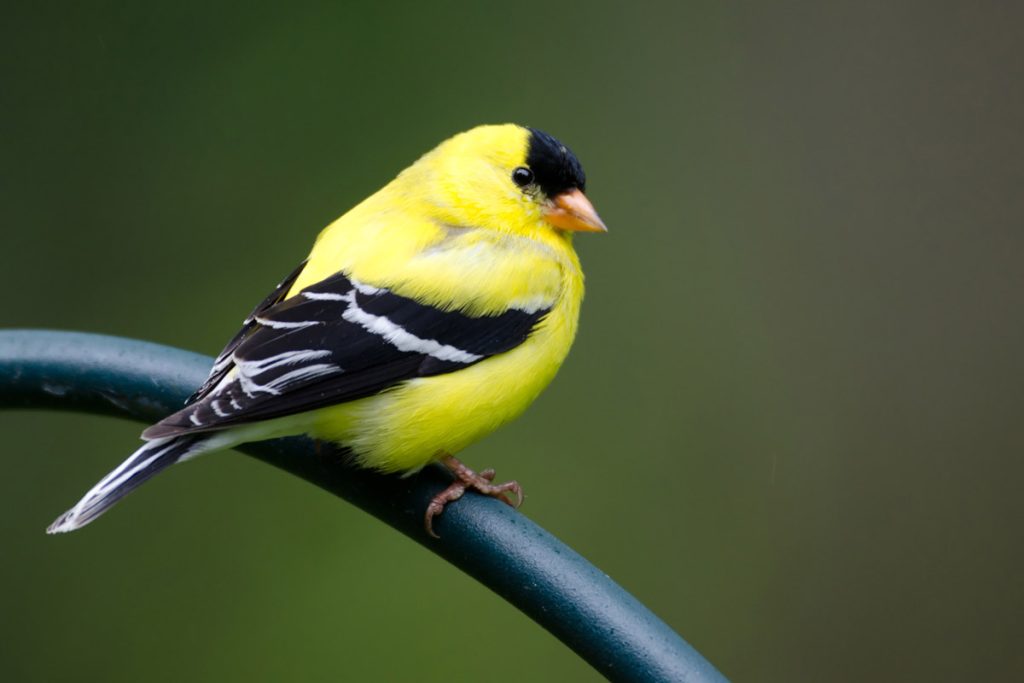
To identify the American Goldfinch, refer to the provided pictures. These birds can be seen throughout the year in Virginia. Their population increases during the breeding season, as evident from 39% of summer checklists and 27% of winter checklists submitted by bird watchers.
The males of this species display vibrant yellow and black plumage during spring, while females and males appear duller brown during winter.
Scientific name: Spinus tristis
Size: 4.3-5.1 inches (11-13 cm)
Weight: 0.4-0.7 ounces (11-20 g)
Wingspan: 7.5-8.7 inches (19-22 cm)
American Goldfinches can be found across most of North America and are usually resident throughout the year. However, those breeding in Canada and the Midwest migrate to southern US states for winter.
These birds can be observed foraging for food such as sunflower, thistle, and aster plants in weedy fields, overgrown areas, suburbs, parks, and even backyards.
Listen to the American Goldfinch song to familiarize yourself with their melodic tunes. Their nests are usually built in shrubs using rootlets and plant material, held together with spiders’ webs. A typical clutch consists of up to seven eggs, with a hatching period of around two weeks and an additional two to two and a half weeks for the young to leave the nest.
To attract American Goldfinches to your backyard, consider planting thistles and milkweed. They are known to visit various bird feeders and have a preference for sunflower seeds and nyjer seeds.
Interesting fact: Due to their vegetarian diet, American Goldfinches do not raise cowbird chicks, resulting in their unfortunate demise within a few days.
2. Yellow-rumped Warbler

The Yellow-rumped Warbler is a winter visitor to Virginia, but its numbers increase during migration. These birds are documented in 19% of winter checklists and up to 35% of checklists during migration.
Yellow-rumped Warblers feature gray plumage with flashes of yellow on the face, sides, and rump, accompanied by white markings on the wings.
Females may exhibit a slightly brown coloration, while winter birds display paler brown tones with bright yellow rumps and sides, transitioning back to yellow and gray during spring.
Scientific name: Setophaga coronata
Size: 4.7-5.5 inches (12-14 cm)
Weight: 0.4-0.5 ounces (12-13 g)
Wingspan: 7.5-9.1 inches (19-23 cm)
Yellow-rumped Warblers predominantly breed in Canada, parts of the Rockies, and the Appalachian Mountains. During migration, they can be seen in the Midwest before overwintering in southern and southwestern US states, along the Pacific Coast, and even extending into Mexico and Central America.
You are likely to find Yellow-rumped Warblers in coniferous forests, especially during the breeding season. In winter, they tend to frequent open areas with fruiting shrubs. Their diet primarily consists of insects during the summer, while fruits such as bayberry and wax myrtle become their main food source during migration and winter.
Listen to the Yellow-rumped Warbler’s song to recognize their unique vocalizations. Their nests, constructed by females, are typically built in conifer trees using twigs, pine needles, and grass. The interior is lined with soft grass, moss, and hair. A clutch usually contains up to six eggs, which hatch after approximately two weeks, followed by another two weeks for the young to fledge.
To attract Yellow-rumped Warblers to your backyard, provide a variety of food sources such as tube feeders and platform feeders with millet, cracked corn, sunflower seeds, peanut hearts, and suet. Additionally, consider planting native fruit-bearing trees and vines like bayberry, grape, sumac, and Virginia creeper.
Interesting fact: Yellow-rumped Warblers often form flocks numbering in the thousands during winter, and they can be quite territorial towards other species that encroach upon their space.
3. Cedar Waxwing
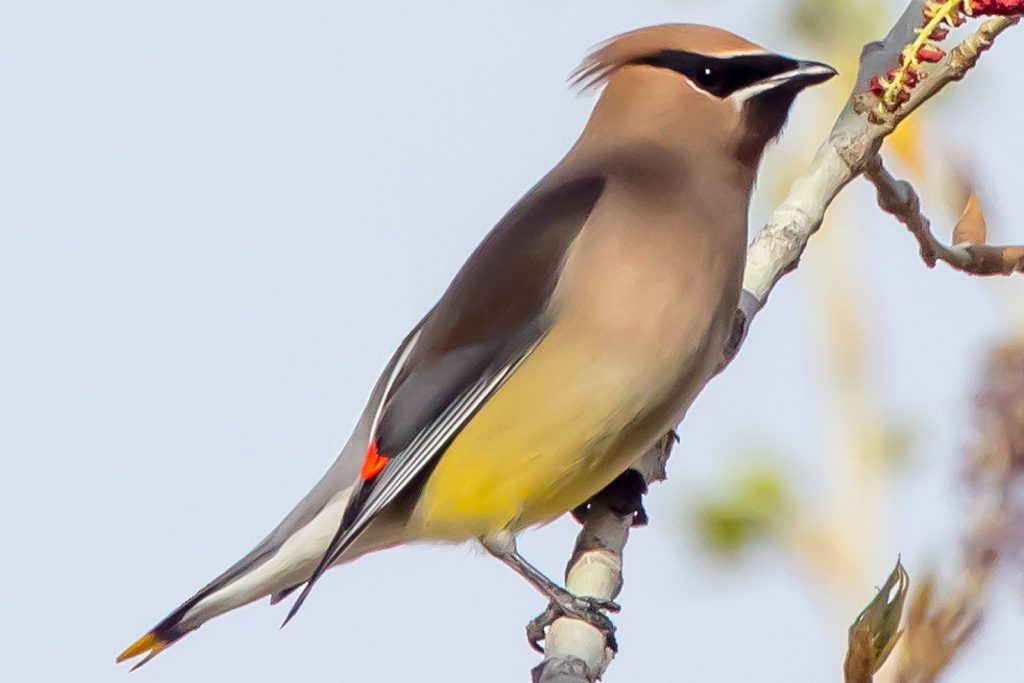
Cedar Waxwings can be observed in Virginia throughout the year, but they are more commonly seen during the breeding season. They appear in approximately 12% of summer checklists and 5% of winter checklists in the state.
These elegant and sociable birds have pale brown heads, chests, and crests that transition to gray on their backs and wings. Their bellies are pale yellow, and their tails display bright yellow tips. Cedar Waxwings possess a narrow black mask around their eyes and vibrant red on their wingtips.
Scientific name: Bombycilla cedrorum
Size: 5.5-6.7 inches (14-17 cm)
Weight: 1.1 ounces (32 g)
Wingspan: 8.7-11.8 inches (22-30 cm)
Cedar Waxwings breed in Canada before migrating to the southern United States, Mexico, and Central America for winter. They remain resident year-round in the northern US states.
These birds can be found in berry bushes, woodlands, grasslands, towns, and areas along streams. While they mainly feed on fruit, they also consume insects during the summer.
Listen to the Cedar Waxwing’s call to become familiar with their vocalizations. When constructing nests, female Cedar Waxwings utilize tw
igs, grass, hair, and plant materials. These nests are lined with pine needles and soft grass. Clutches consist of up to six eggs, with an incubation period of around twelve days, followed by sixteen or so days for the young to leave the nest.
To attract Cedar Waxwings to your backyard, consider planting native trees and shrubs that bear small fruit, such as serviceberry, dogwood, juniper, winterberry, and hawthorn. Additionally, you can provide fruit on platform feeders.
Interesting fact: Cedar Waxwings engage in gift-giving behaviors during courtship, passing objects between potential mates.
4. Common Yellowthroat
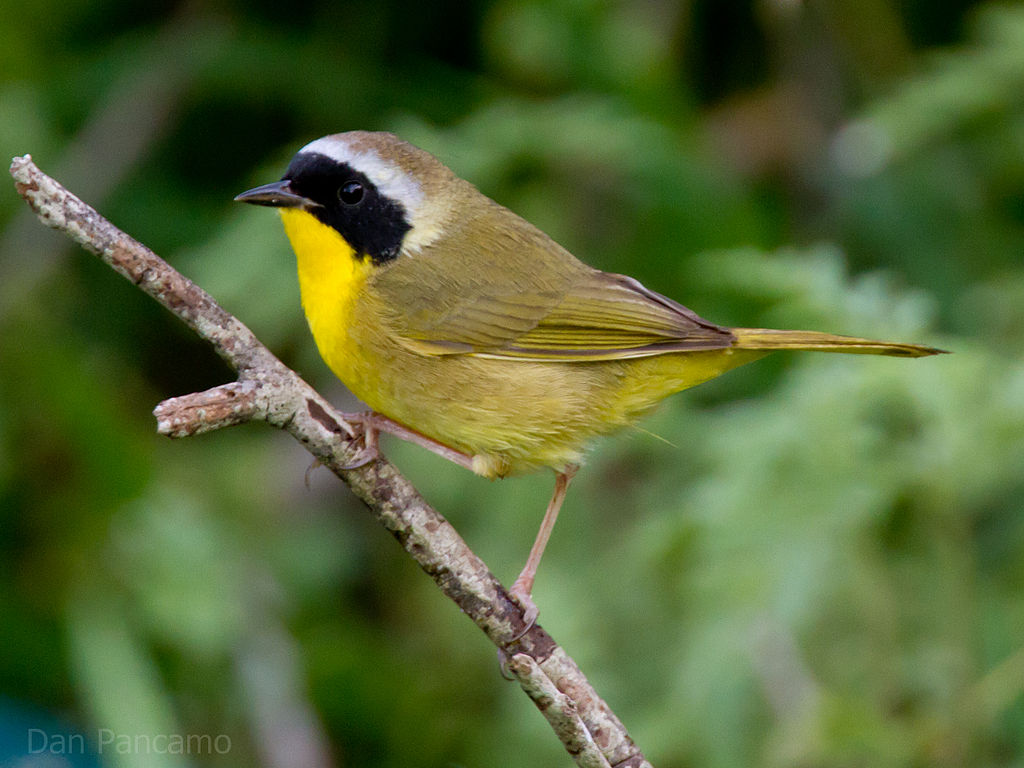
During the breeding season, the Common Yellowthroat ranks as the second most frequently spotted yellow bird species in Virginia. They appear in approximately 18% of summer checklists in the state.
Common Yellowthroats are small songbirds with brownish backs and vibrant yellow undersides. They possess long tails, and the males showcase black masks across their faces. The intensity of their yellow coloration may vary geographically, with some individuals displaying more olive tones on their undersides.
Scientific name: Geothlypis trichas
Size: 4.3-5.1 inches (11-13 cm)
Weight: 0.3-0.3 ounces (9-10 g)
Wingspan: 5.9-7.5 inches (15-19 cm)
Common Yellowthroats breed throughout most of North America, excluding Alaska and northern Canada. Some populations remain along the Gulf Coast and Pacific Southwest year-round, while others migrate south for the winter.
These birds can often be found in marshy or wetland areas and brushy fields, seeking refuge amidst thick, tangled vegetation.
Listen to the Common Yellowthroat’s song to recognize their characteristic melodies. Female Common Yellowthroats construct their nests near the ground in marshy areas, supported by reeds. The nests are composed of grass, sedges, and supported on a platform of leaves and grass. Clutches contain up to six eggs, which incubate for approximately twelve days, followed by the same duration for the young to leave the nest.
To attract Common Yellowthroats to larger backyards, provide dense vegetation and native plants that attract insects.
Interesting fact: Male Common Yellowthroats interpret the presence of a black mask on other birds as a sign of another male, often resulting in aggressive behaviors. However, they do not display aggression when encountering birds without masks.
5. Pine Warbler
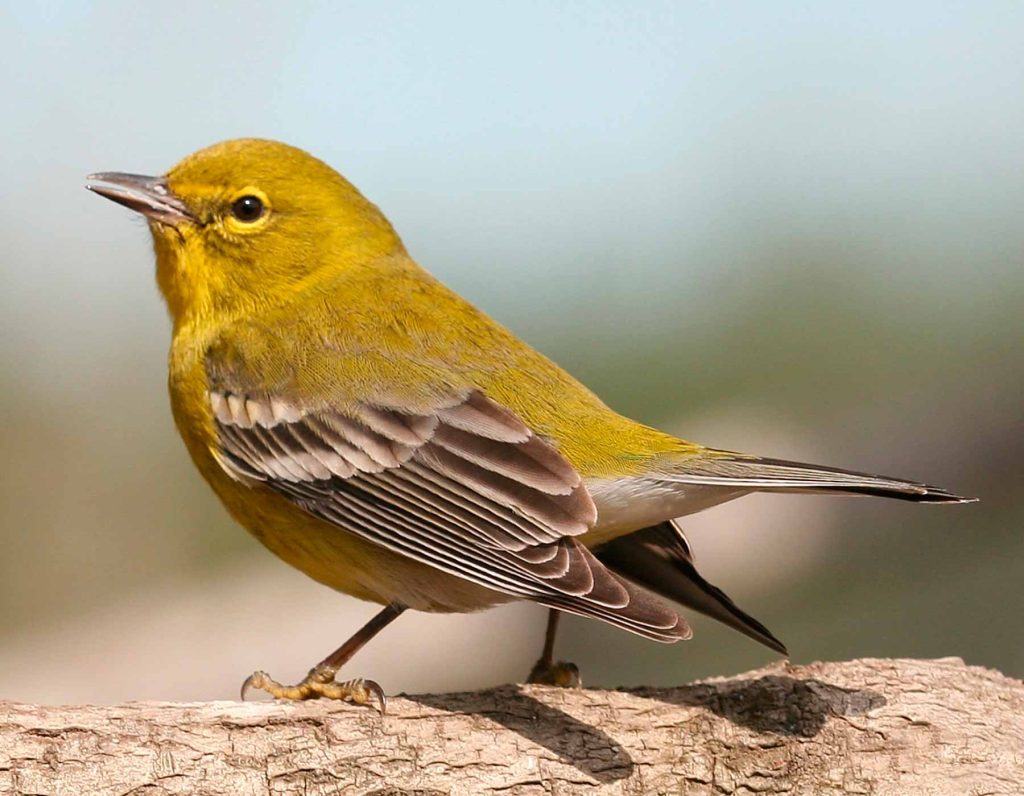
Pine Warblers can be spotted year-round in Virginia, with higher frequencies from February to June. They appear in approximately 8% of summer checklists and 4% of winter checklists submitted by bird watchers.
These plump, small yellow birds feature olive backs, white lower bellies, and gray wingbars. Females may exhibit browner hues and display more white on their bellies.
Scientific name: Setophaga pinus
Size: 5.1-5.5 inches (13-14 cm)
Weight: 0.3-0.5 ounces (9-15 g)
Wingspan: 7.5-9.1 inches (19-23 cm)
Pine Warblers breed in northeastern US states before migrating to southeastern US states. Some individuals remain resident year-round in the southeastern US.
These birds primarily inhabit pine forests, often occupying higher branches. They feed on caterpillars, beetles, spiders, and other insects and larvae. During colder weather, they incorporate fruits and seeds into their diet.
Listen to the Pine Warbler’s song to become familiar with their distinct vocalizations. Their nests, constructed in pine trees, consist of twigs, bark, pine needles, and grass, held together
with spider silk. The interior is lined with feathers and animal hair. Clutches typically contain up to five eggs, with an incubation period of two weeks and another ten days for the young to fledge.
To attract Pine Warblers to your yard, consider providing tube feeders and platform feeders with millet, cracked corn, sunflower seeds, peanut hearts, and suet. Planting native fruit-bearing trees and vines like bayberry, grape, sumac, and Virginia creeper can also be effective.
Interesting fact: Pine Warblers primarily consume seeds, making them more likely visitors to backyard feeders compared to other warbler species.
6. Eastern Meadowlark
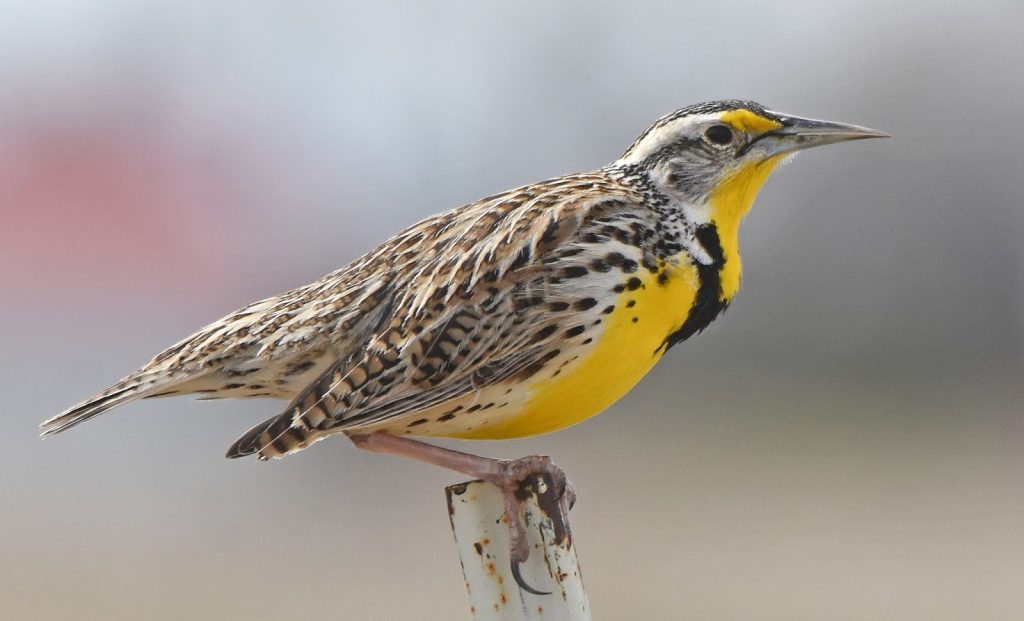
Eastern Meadowlarks are classified as near-threatened species in Virginia. While they can be spotted year-round, they are most commonly observed from March to July, appearing in approximately 8% of summer checklists and 2% of winter checklists.
These medium-sized songbirds feature bright yellow undersides, pale brown bodies with black markings on the back, and a distinctive black band across the chest.
Scientific name: Sturnella magna
Size: 7.5-10.2 inches (19-26 cm)
Weight: 3.2-5.3 ounces (90-150 g)
Wingspan: 13.8-15.8 inches (35-40 cm)
Eastern Meadowlarks can be found throughout eastern US states year-round. They also breed in the Northeast and Canada before embarking on migration journeys to southern destinations.
The arrival of spring is heralded by the melodic songs and captivating displays of Eastern Meadowlarks. Unfortunately, they are now considered near-threatened.
You can find Eastern Meadowlarks on the ground in grasslands and prairies, where they feed on insects. In winter, they gather in large flocks in fields, foraging for seeds.
Eastern Meadowlarks produce flute-like whistles that are clear and melodious. The construction of their nests involves impressive techniques, including tunnels and roofs made of woven grasses.
Interesting fact: Eastern Meadowlarks are capable of singing more than 100 distinct songs.
7. Scarlet Tanager (Female)
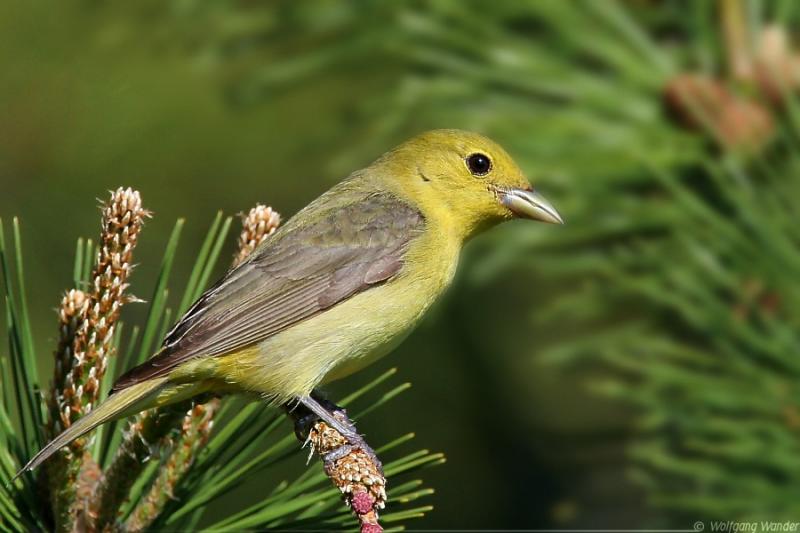
During the summer months in Virginia, from April to mid-November, Scarlet Tanagers can be observed. They appear in approximately 14% of checklists during this period.
Female Scarlet Tanagers exhibit yellow plumage with darker wings and tails. Similarly, males display striking colors, with black heads and backs, and reddish undersides.
Scientific name: Piranga olivacea
Size: 6.3-6.7 inches (16-17 cm)
Weight: 0.8-1.3 ounces (23-38 g)
Wingspan: 9.8-11.4 inches (25-29 cm)
Scarlet Tanagers breed in eastern forests before migrating to western South America. During their migrations, they can be spotted in southeastern US states.
Scarlet Tanagers tend to remain hidden in the forest canopy, making them challenging to spot. However, their bright red plumage may occasionally catch your eye as they navigate branches in search of insects.
Listen to the Scarlet Tanager’s song to familiarize yourself with their beautiful melodies. Female Scarlet Tanagers construct nests using loosely woven twigs, grass, and plant materials. The interior is lined with soft grass, pine needles, and other materials. Clutches typically consist of around four eggs, which incubate for two weeks, followed by a further two weeks for the young to fledge.
To attract Scarlet Tanagers to your backyard, consider planting berry-bearing plants such as blackberries, raspberries, huckleberries, juneberries, serviceberries, mulberries, strawberries, and chokeberries.
Interesting fact:
Male Scarlet Tanagers engage in singing battles, sometimes escalating into physical fights.
8. American Redstart (Female)
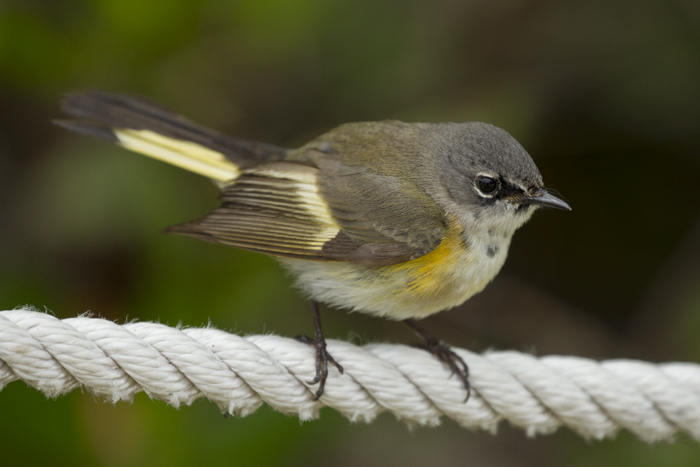
American Redstarts are commonly observed during migration in Virginia, with some individuals also spending the breeding season in the area. They appear in approximately 9% of summer checklists and up to 20% of checklists during fall migration.
Male American Redstarts feature mostly black plumage with vibrant orange patches and a white belly. Females, on the other hand, exhibit olive-gray coloring instead of black, with numerous yellow patches.
Scientific name: Setophaga ruticilla
Size: 4.3-5.1 inches (11-13 cm)
Weight: 0.2-0.3 ounces (6-9 g)
Wingspan: 6.3-7.5 inches (16-19 cm)
American Redstarts breed in eastern US states, Canada, and Northwestern US states. During migration, they may also be seen in central and western US states.
These birds can be found in deciduous woodlands, where they actively forage for insects. They may also appear in backyards and thickets, feasting on berries such as serviceberry and magnolia.
Listen to the American Redstart’s song to recognize their unique vocalizations. Female American Redstarts construct nests close to the trunk of trees or large shrubs, using bark, grass, and plant materials. Clutches typically consist of up to five eggs, which incubate for just under two weeks.
To attract American Redstarts to your backyard, consider planting berry-producing trees and shrubs such as magnolia and serviceberry.
Interesting fact: American Redstart parents selectively feed specific chicks rather than feeding all of them uniformly.
9. White-eyed Vireo
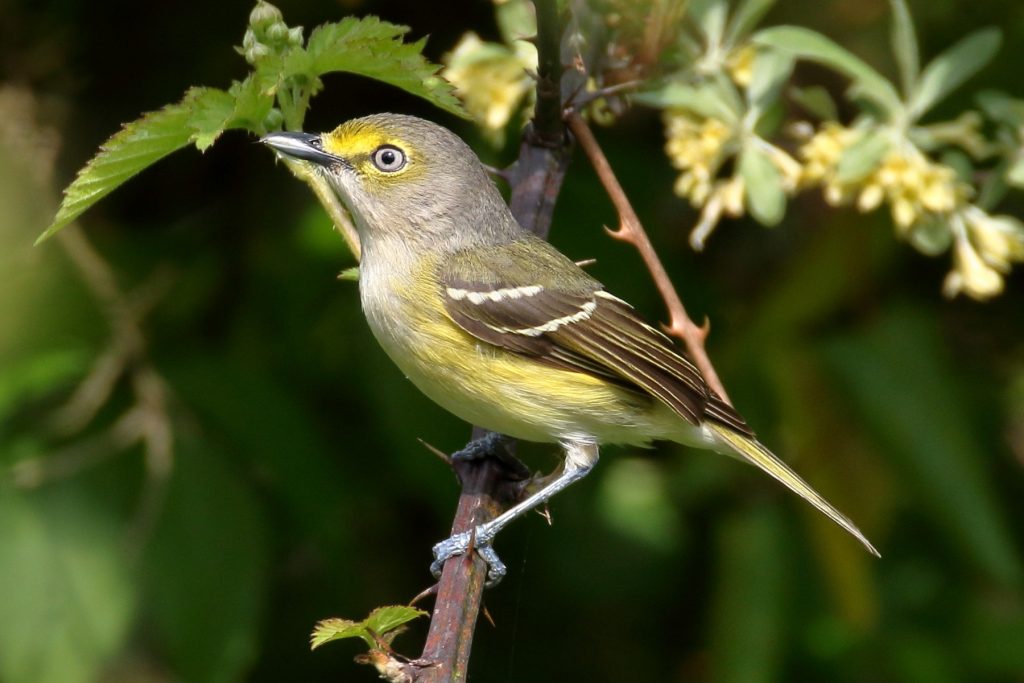
White-eyed Vireos spend the breeding season in Virginia, primarily from April to mid-October. They appear in approximately 8% of summer checklists in the state.
White-eyed Vireos possess gray heads with yellow markings around their foreheads and striking white eyes. Their chests and throats are white, and they have yellow sides, greenish backs with darker wings, and two white wingbars.
Scientific name: Vireo griseus
Size: 4.3-5.1 inches (11-13 cm)
Weight: 0.3-0.5 ounces (10-14 g)
Wingspan: 6.7 inches (17 cm)
White-eyed Vireos spend their summers across the southeastern United States, often concealed within thickets. Some individuals near the coast remain resident year-round, while they winter along the southeast coast of Mexico and the Caribbean.
These vireos can be found in overgrown pastures, brambles, and areas along streams, where they feed on insects, flies, and spiders. In winter, they also consume berries.
Listen to the White-eyed Vireo’s song to become acquainted with their distinctive vocalizations. Their nests, which resemble cups, hang from branches in shrubs. These nests are constructed using spider webs, leaves, bark, and plant materials.
White-eyed Vireos lay approximately four eggs, which incubate for two weeks, with an additional ten days for the young to fledge.
Interesting fact: While both male and female White-eyed Vireos sing during winter, only the males vocalize during spring and summer, often producing melodic songs from dawn until lunchtime.
10. Orchard Oriole (Female)

Orchard Orioles can be spotted in Virginia during the breeding season, appearing in approximately 11% of summer checklists. Their presence can be observed from April, and they begin their migration in September.
Female Orchard Orioles display greenish-yellow plumage, appearing paler underneath and darker on the back. They
also exhibit darker wings and white wingbars.
Scientific name: Icterus spurius
Size: 5.9-7.1 inches (15-18 cm)
Weight: 0.6-1.0 ounce (16-28 g)
Wingspan: 9.8 inches (25 cm)
During the summer, Orchard Orioles breed in the eastern half of the United States before migrating south to Mexico and Central America. These birds prefer open woodlands but can also be found along riverbanks, in open shrublands, farms, and even backyards. They construct hanging pouch-like nests.
Their diet primarily consists of insects such as ants, caterpillars, beetles, and grasshoppers, as well as spiders. Orchard Orioles also drink nectar from flowers and consume fruit like mulberries and chokeberries.
Listen to the Orchard Oriole’s sounds to recognize their jumbled series of whistles, lasting approximately 3 to 4 seconds.
Their nests, hanging from small branches, are composed of long grasses. They incorporate spiders’ webs to form the initial shape, and leaves, bark, and plant material to create a secure structure. Clutches contain four to six eggs, with an incubation period of about two weeks.
To attract Orchard Orioles to your yard, provide hummingbird feeders or platform feeders with cut oranges or mango. Planting native berry-bearing plants such as mulberries or chokeberries can also be beneficial.
Interesting fact: Orchard Orioles are the smallest species of blackbird in North America.
11. Baltimore Oriole

Baltimore Orioles can be observed in Virginia during the breeding season, appearing in approximately 14% of summer checklists. They typically arrive in April and begin their migration in September.
Male Baltimore Orioles are known for their vibrant orange plumage with black wings and head. Females, on the other hand, display more subdued colors, featuring yellowish-orange undersides and grayish-olive wings.
Scientific name: Icterus galbula
Size: 7.5-8.7 inches (19-22 cm)
Weight: 1.0-1.4 ounces (28-40 g)
Wingspan: 9.8-11.8 inches (25-30 cm)
During the summer, Baltimore Orioles breed across eastern North America. They construct remarkable hanging nests woven from plant fibers, typically attached to the outer branches of trees.
These Orioles can be found in a variety of habitats, including open woodlands, forest edges, and even suburban areas. They primarily feed on nectar, fruits, and insects.
Listen to the Baltimore Oriole’s song, characterized by a series of rich, flute-like notes.
Their nests are intricately woven, often resembling hanging baskets. Baltimore Orioles lay clutches of three to seven eggs, which incubate for around two weeks.
To attract Baltimore Orioles to your yard, provide feeders with orange halves, grape jelly, and nectar solutions. Planting fruit-bearing trees such as mulberry, cherry, or apple can also be enticing.
Interesting fact: Baltimore Orioles were named after the colors of Lord Baltimore, a prominent figure in the founding of Maryland.
12. Prairie Warbler
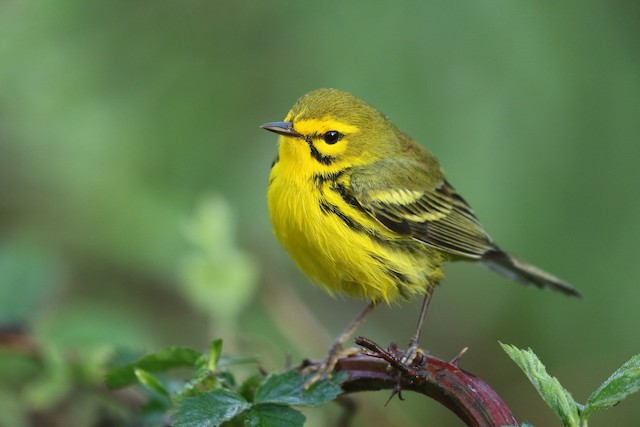
Prairie Warblers are migratory birds that can be spotted in Virginia during the summer season, appearing in approximately 7% of summer checklists. They arrive in April and begin their migration in September.
Prairie Warblers have yellow plumage with black streaks on their sides, backs, and throats. Males exhibit more prominent black markings and a bold, black facial pattern.
Scientific name: Setophaga discolor
Size: 4.3-5.1 inches (11-13 cm)
Weight: 0.3-0.4 ounces (9-11 g)
Wingspan: 5.9-6.7 inches (15-17 cm)
During the summer breeding season, Prairie Warblers can be found in open habitats such as grasslands, shrubby areas, and young forests. They feed on insects, including caterpillars, beetles, and spiders.
Listen to the Prairie Warbler’s distinctive song, consisting of buzzy trills and musical notes.
Their nests are built in low shrubs or young trees, often near the ground. Females construct cup-shaped nests using grasses, bark, and plant fibers. Clutches usually contain three to five eggs, which incubate for approximately two weeks.
To attract Prairie Warblers to your yard, provide a mix of open and shrubby areas, along with suitable habitat for insects. Native shrubs like blackberry and elderberry can also be beneficial.
Interesting fact: Prairie Warblers are known for their ground-foraging behavior, searching for insects and spiders among the low vegetation.
13. Yellow-throated Vireo

Yellow-throated Vireos can be observed in Virginia during the summer breeding season, appearing in approximately 4% of summer checklists. They typically arrive in April and begin their migration in September.
Yellow-throated Vireos feature yellow undersides, olive-green backs, and striking yellow throats. They also have white wingbars and a distinct black line through their eyes.
Scientific name: Vireo flavifrons
Size: 5.9-6.7 inches (15-17 cm)
Weight: 0.6-0.8 ounces (17-22 g)
Wingspan: 9.4-10.2 inches (24-26 cm)
During the summer, Yellow-throated Vireos breed in deciduous and mixed forests across the eastern United States. They primarily feed on insects, spiders, and caterpillars.
Listen to the Yellow-throated Vireo’s song, characterized by a series of repeated phrases and musical notes.
Their nests are pendulous structures, often suspended from the forked branches of trees. Constructed by the female, the nests are made of bark strips, grass, and plant fibers, and are lined with fine materials. Clutches typically consist of three to four eggs, with an incubation period of around two weeks.
To attract Yellow-throated Vireos to your yard, maintain a diverse forested habitat and provide ample food sources for insects.
Interesting fact: Yellow-throated Vireos are known for their close association with trees, rarely venturing far from forested areas.
14. Yellow-throated Warbler
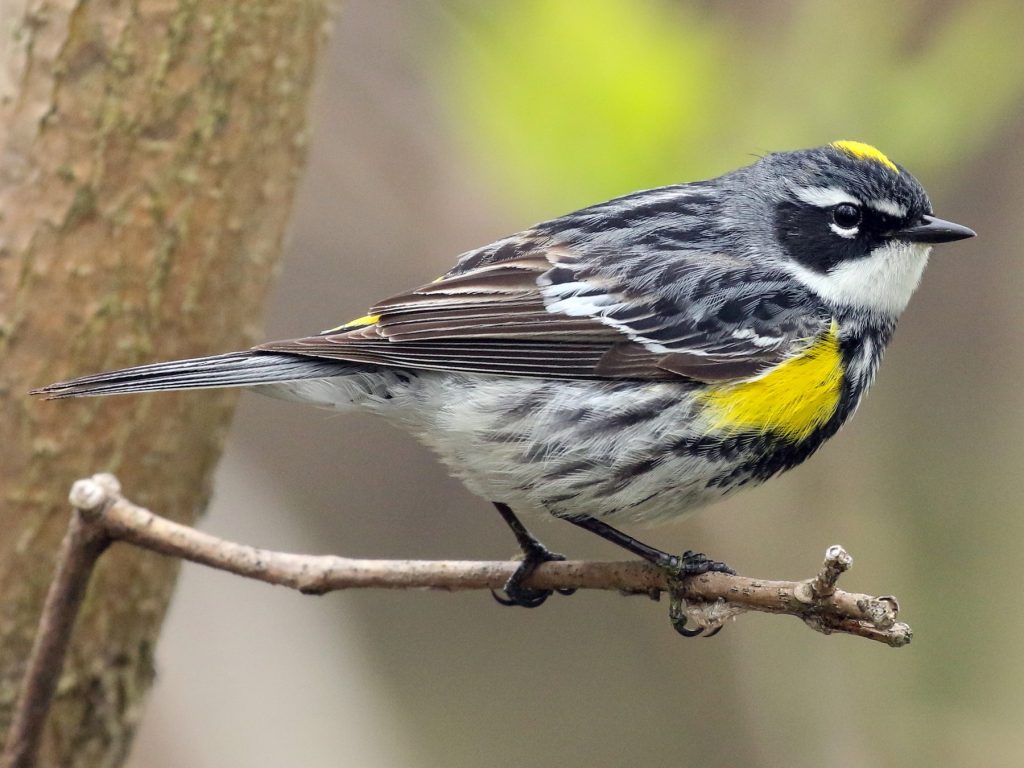
Yellow-throated Warblers can be spotted in Virginia during the summer breeding season, appearing in approximately 3% of summer checklists. They arrive in April and begin their migration in September.
Yellow-throated Warblers display striking yellow throats and undersides, with black streaks on their backs and white wingbars. Males also have distinctive black masks.
Scientific name: Setophaga dominica
Size: 4.7-5.1 inches (12-13 cm)
Weight: 0.3-0.4 ounces (9-12 g)
Wingspan: 7.5-8.7 inches (19-22 cm)
During the summer, Yellow-throated Warblers breed in southeastern and eastern regions of the United States. They inhabit forested areas, including swamps, bottomlands, and riparian zones.
Listen to the Yellow-throated Warbler’s song, characterized by a series of high, clear notes.
Their nests are cup-shaped structures made from twigs, bark, moss, and grass, lined with fine materials. Clutches typically contain three to five eggs, with an incubation period of around two weeks.
To attract Yellow-throated Warblers to your yard, maintain a wooded habitat with diverse tree species, especially those near water sources.
Interesting fact: Yellow-throated Warblers are known for their insect-hunting behavior, often catching insects while hovering or gleaning them from foliage.
15. Hooded Warbler
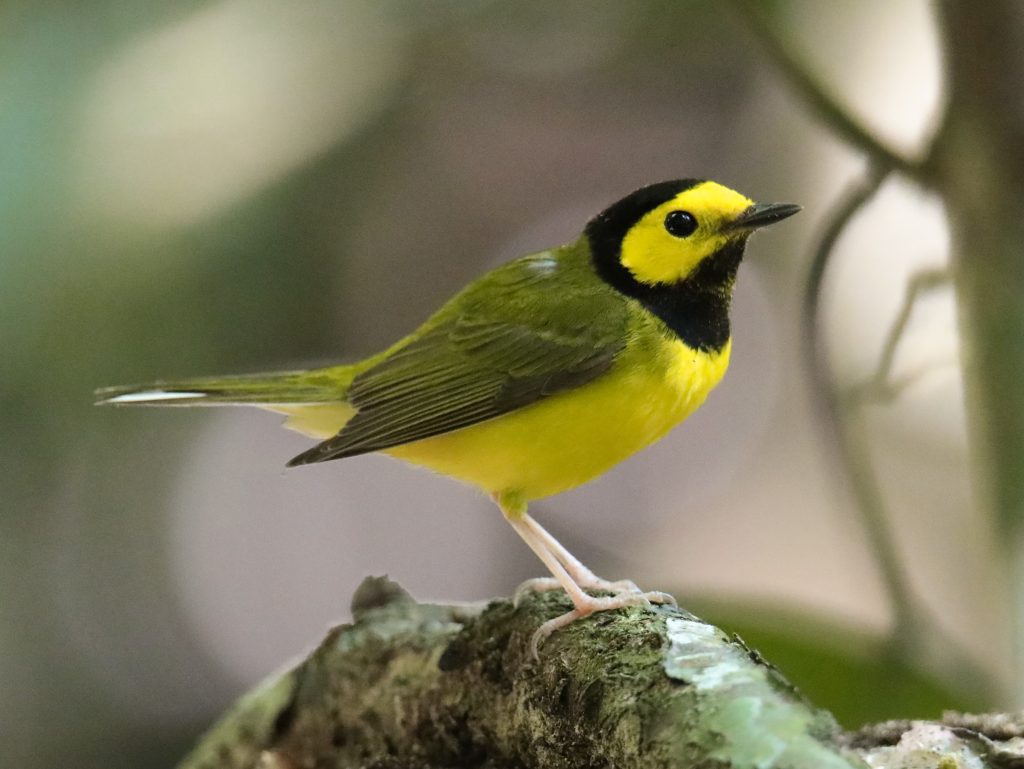
Hooded Warblers can be observed in Virginia during the summer breeding season, appearing in approximately 9% of summer checklists. They arrive in April and begin their migration in September.
Hooded Warblers feature bright yellow faces, underparts, and hoods, with olive-green backs and black streaks on their wings and tails. Males have a distinctive black hood that surrounds their yellow face.
Scientific name: Setophaga citrina
Size: 4.3-4.7 inches (11-12 cm)
Weight: 0.3-0.4 ounces (8-11 g)
Wingspan: 6.7-7.5 inches (17-19 cm)
During the summer, Hooded Warblers breed in eastern regions of the United States, particularly in forested areas with dense undergrowth and shrubby habitats. They primarily feed on insects, spiders, and small invertebrates.
Listen to the Hooded Warbler’s song, characterized by a series of high-pitched, whistled notes.
Their nests are cup-shaped structures, usually built on the ground or near the
base of shrubs. Constructed by the female, the nests are made of leaves, grasses, and bark strips, and are lined with fine materials. Clutches typically consist of three to four eggs, with an incubation period of around two weeks.
To attract Hooded Warblers to your yard, maintain a diverse shrubby and forested habitat, providing suitable cover and insect-rich areas.
Interesting fact: Hooded Warblers have a unique foraging behavior called “gleaning,” where they actively search for insects and spiders among leaves and branches.
16. Summer Tanager
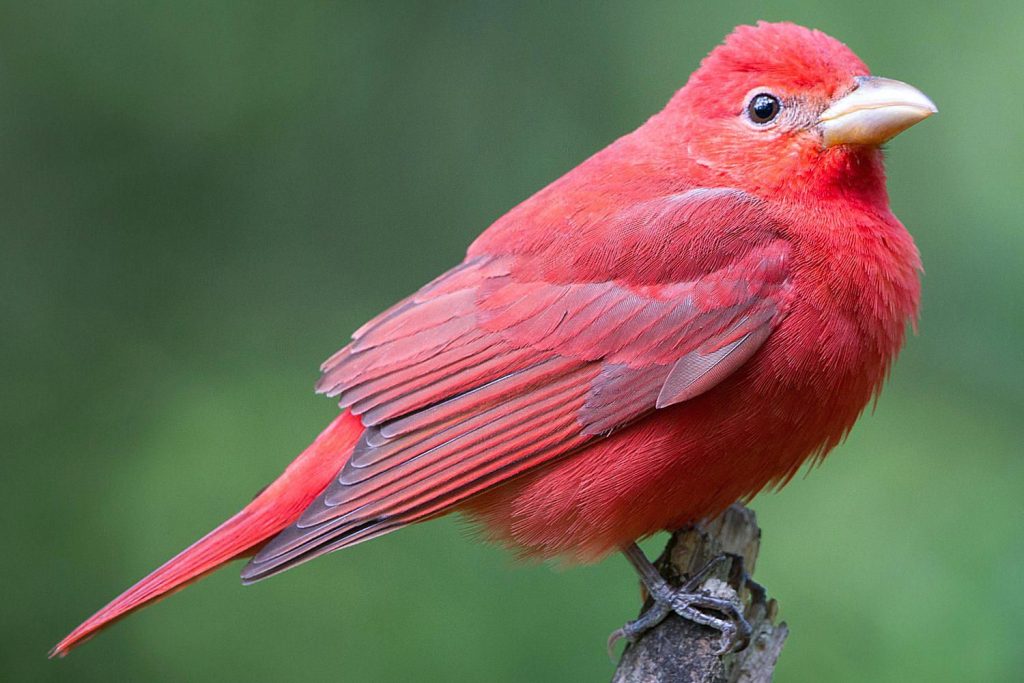
Summer Tanagers can be spotted in Virginia during the summer breeding season, appearing in approximately 7% of summer checklists. They arrive in April and begin their migration in September.
Male Summer Tanagers are known for their vibrant red plumage, while females display a more subdued yellow-green coloration. Both sexes have thick, conical bills.
Scientific name: Piranga rubra
Size: 6.3-7.1 inches (16-18 cm)
Weight: 1.0-1.1 ounces (29-32 g)
Wingspan: 9.4-10.6 inches (24-27 cm)
During the summer, Summer Tanagers breed across the southeastern and southwestern United States. They inhabit open woodlands, forest edges, and riparian areas. These birds primarily feed on insects, including bees, wasps, beetles, and flies.
Listen to the Summer Tanager’s song, characterized by a series of clear, robin-like notes.
Their nests are cup-shaped structures made of bark, grass, and plant fibers, typically placed on horizontal tree branches. Clutches usually contain two to five eggs, with an incubation period of around two weeks.
To attract Summer Tanagers to your yard, provide ample insect habitat and maintain diverse wooded areas.
Interesting fact: Summer Tanagers are known for their unique hunting behavior, where they often catch flying insects in mid-air.
17. Yellow Warbler
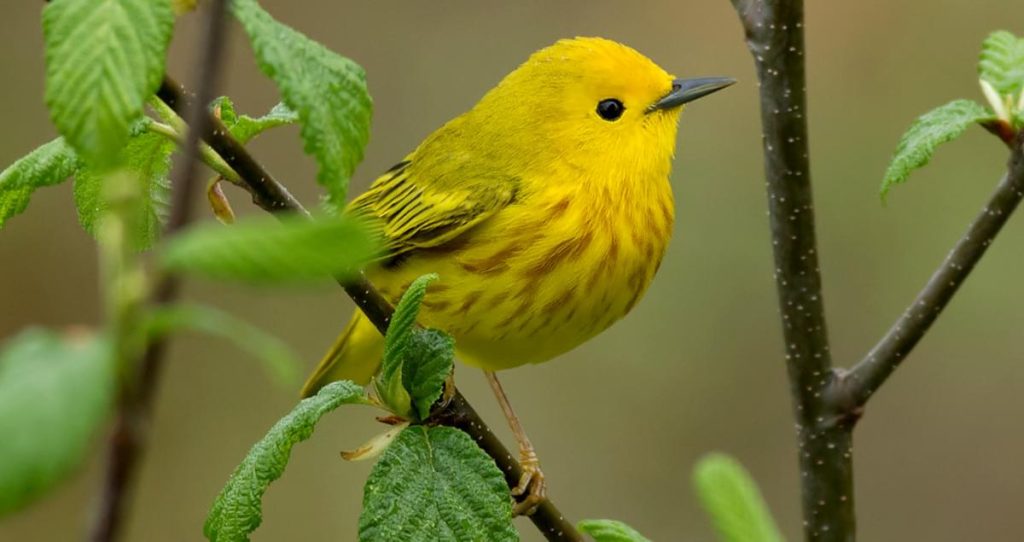
Yellow Warblers can be observed in Virginia during the summer breeding season, appearing in approximately 10% of summer checklists. They arrive in April and begin their migration in September.
Yellow Warblers display vibrant yellow plumage overall, with rusty streaks on their breasts and bold black eyes.
Scientific name: Setophaga petechia
Size: 4.7 inches (12 cm)
Weight: 0.3-0.4 ounces (8-11 g)
Wingspan: 6.7-7.5 inches (17-19 cm)
During the summer, Yellow Warblers breed across North America, from the boreal forests of Canada to the southern United States. They primarily inhabit open woodlands, wetlands, and shrubby areas near water sources.
Listen to the Yellow Warbler’s song, characterized by a series of sweet, melodic notes.
Their nests are cup-shaped structures, usually constructed in shrubs or trees, and made of bark strips, grass, and plant fibers. The nests are often lined with fine materials such as feathers and hair. Clutches typically consist of four to five eggs, with an incubation period of around two weeks.
To attract Yellow Warblers to your yard, provide suitable shrubby habitats near water, and maintain diverse vegetation.
Interesting fact: Yellow Warblers are among the most widespread and well-known warbler species in North America.
18. Black-throated Green Warbler
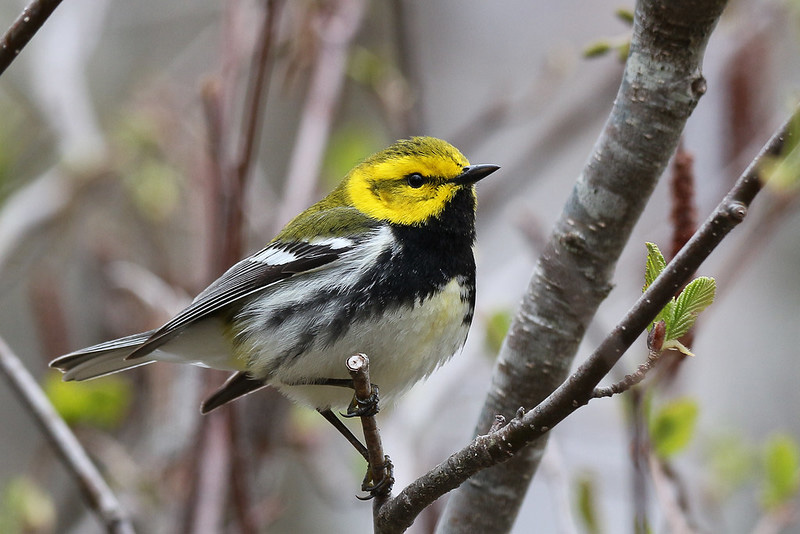
Black-throated Green Warblers can be spotted in Virginia during the summer breeding season, appearing in approximately 8% of summer checklists. They arrive in April and begin their migration in September.
Black-throated Green Warblers have bright yellow plumage with black streaks on their sides and backs. Males exhibit a black
throat and face, while females have a more subdued appearance.
Scientific name: Setophaga virens
Size: 4.7-5.1 inches (12-13 cm)
Weight: 0.3-0.4 ounces (9-12 g)
Wingspan: 7.5-8.7 inches (19-22 cm)
During the summer, Black-throated Green Warblers breed across the boreal forests of North America and parts of the northeastern United States. They primarily inhabit coniferous and mixed forests.
Listen to the Black-throated Green Warbler’s song, characterized by a rising buzz followed by a series of high-pitched notes.
Their nests are cup-shaped structures made of twigs, bark, grass, and moss, often lined with feathers and animal hair. Clutches usually contain three to five eggs, with an incubation period of around two weeks.
To attract Black-throated Green Warblers to your yard, maintain a suitable forested habitat with coniferous trees.
Interesting fact: Black-throated Green Warblers are known for their distinctive buzzy song, often described as “zee-zee-zoo-zoo-zee.”
19. Prothonotary Warbler
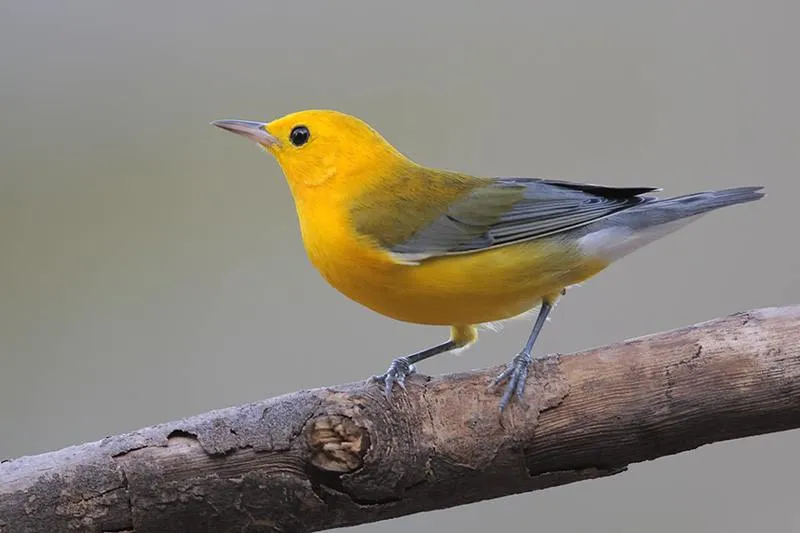
Prothonotary Warblers can be observed in Virginia during the summer breeding season, appearing in approximately 6% of summer checklists. They arrive in April and begin their migration in September.
Prothonotary Warblers display vibrant yellow plumage with a bluish-gray back and wings. Males have a bold orange crown, while females exhibit a more subdued coloration.
Scientific name: Protonotaria citrea
Size: 4.3-5.1 inches (11-13 cm)
Weight: 0.4-0.5 ounces (11-15 g)
Wingspan: 7.5-8.7 inches (19-22 cm)
During the summer, Prothonotary Warblers breed in swampy forests and wetland areas across the southeastern United States. They primarily inhabit wooded swamps, floodplains, and riverbanks.
Listen to the Prothonotary Warbler’s song, characterized by a series of ringing, high-pitched notes.
Their nests are cup-shaped structures, often built in tree cavities or nest boxes near water sources. Constructed by the female, the nests are made of moss, leaves, and plant fibers, and are lined with feathers. Clutches typically consist of four to seven eggs, with an incubation period of around two weeks.
To attract Prothonotary Warblers to your yard, provide suitable nest boxes near water or maintain swampy habitats.
Interesting fact: Prothonotary Warblers are the only eastern warbler species that nest in natural or artificial cavities.
20. Canada Warbler
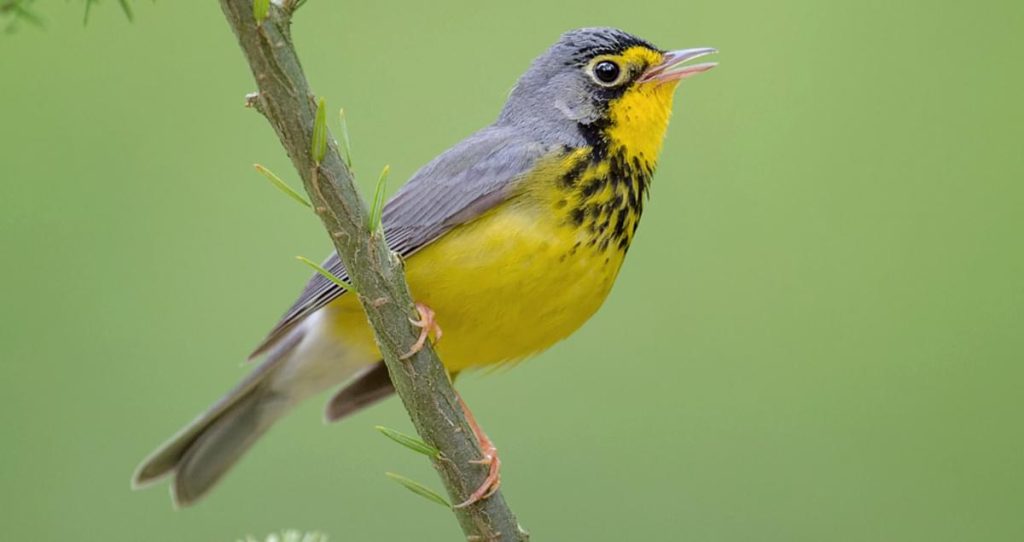
Canada Warblers can be spotted in Virginia during the summer breeding season, appearing in approximately 6% of summer checklists. They arrive in April and begin their migration in September.
Canada Warblers feature grayish-blue upperparts, bright yellow throats and breasts, and distinctive black “necklaces” across their chests.
Scientific name: Cardellina canadensis
Size: 4.7-5.1 inches (12-13 cm)
Weight: 0.3-0.4 ounces (9-12 g)
Wingspan: 7.5-8.3 inches (19-21 cm)
During the summer, Canada Warblers breed in the boreal forests of Canada and northeastern regions of the United States. They primarily inhabit moist, dense woodlands and areas near water.
Listen to the Canada Warbler’s song, characterized by a series of buzzy, rising notes.
Their nests are cup-shaped structures
, typically built on or near the ground in dense vegetation. Constructed by the female, the nests are made of leaves, moss, and plant fibers, and are lined with fine materials. Clutches usually contain four to five eggs, with an incubation period of around two weeks.
To attract Canada Warblers to your yard, maintain a suitable forested habitat with understory vegetation.
Interesting fact: Canada Warblers have one of the longest migrations among the wood warbler species, traveling from their breeding grounds in Canada to wintering grounds in northern South America.
21. Dickcissel
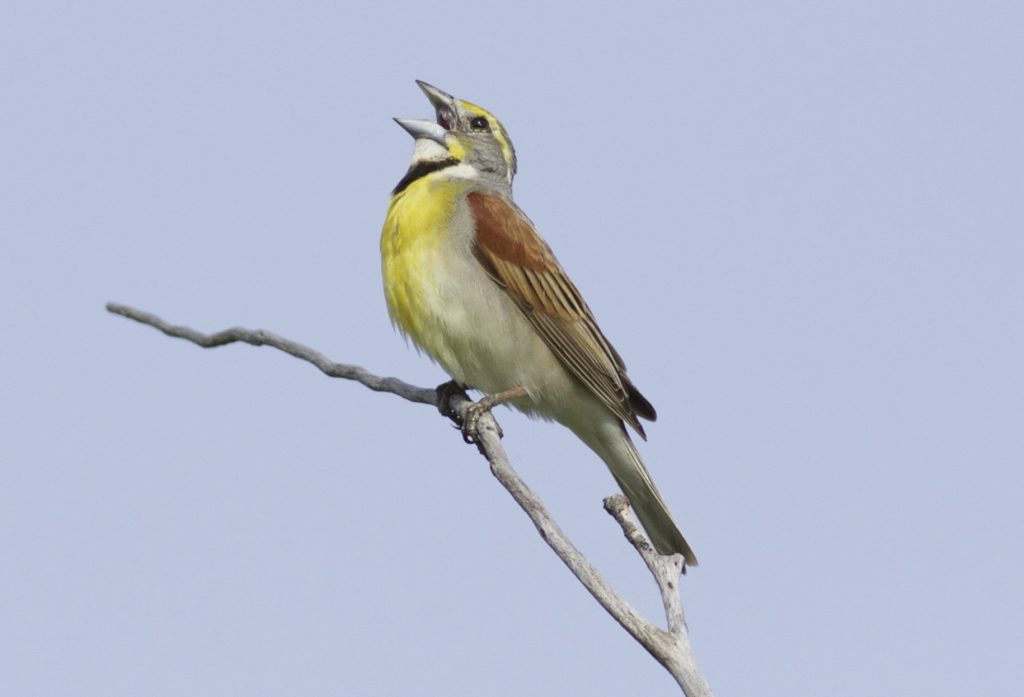
Dickcissels can be observed in Virginia during migration, appearing in approximately 2% of checklists during this time. They are typically seen from April to June and from August to October.
Male Dickcissels have yellow breasts with distinctive black “V” markings, grayish-brown backs, and black streaks on their sides. Females have more subdued colors, with brownish-yellow plumage.
Scientific name: Spiza americana
Size: 5.9-6.7 inches (15-17 cm)
Weight: 0.7-1.0 ounces (20-29 g)
Wingspan: 10.6-11.4 inches (27-29 cm)
During migration, Dickcissels pass through Virginia while traveling to their breeding grounds in the central United States and Mexico. They inhabit grasslands, prairies, and agricultural fields during this time.
Listen to the Dickcissel’s song, characterized by a series of buzzy, insect-like notes and sharp “dick-dick” calls.
Their nests are cup-shaped structures, usually built on the ground in grassy areas or low vegetation. Constructed by the female, the nests are made of grasses, stems, and plant fibers, and are lined with fine materials. Clutches typically consist of three to five eggs, with an incubation period of around two weeks.
Since Dickcissels are primarily observed during migration in Virginia, providing open grassy areas with suitable foraging opportunities can attract them.
Interesting fact: Dickcissels are known for their distinctive “dick-dick” calls, which give them their name.
22. Palm Warbler
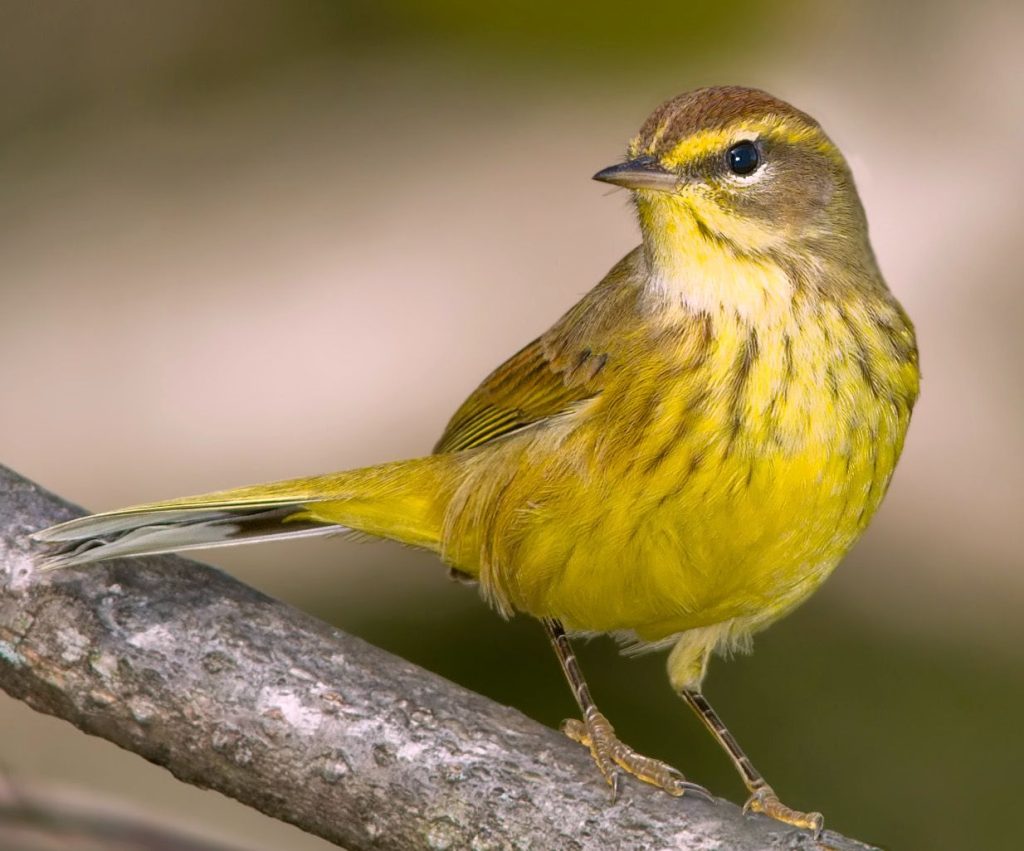
Palm Warblers can be spotted in Virginia during migration, appearing in approximately 8% of checklists during this time. They are typically seen from March to May and from September to October.
Palm Warblers display brownish-olive upperparts, yellow underparts, and distinctive rusty-colored caps. They also have bold black eye lines and white wingbars.
Scientific name: Setophaga palmarum
Size: 4.7-5.1 inches (12-13 cm)
Weight: 0.3-0.4 ounces (8-11 g)
Wingspan: 7.1-7.5 inches (18-19 cm)
During migration, Palm Warblers pass through Virginia while traveling from their wintering grounds in the southeastern United States and the Caribbean to their breeding grounds in northern Canada. They inhabit a variety of habitats, including open woodlands, shrubby areas, and marshes.
Listen to the Palm Warbler’s song, characterized by a series of high-pitched, trilling notes.
Their nests are cup-shaped structures, usually built on or near the ground in dense vegetation. Constructed by the female, the nests are made of grasses, leaves, and plant fibers, and are lined with fine materials. Clutches typically consist of four to five eggs, with an incubation period of around two weeks.
Since Palm Warblers are primarily observed during migration in Virginia, providing suitable habitat with diverse vegetation can attract them.
Interesting fact: Palm Warblers are known
for their distinctive “tail-wagging” behavior, where they constantly flick their tails up and down while foraging on the ground.
23. Blue Grosbeak

Blue Grosbeaks can be observed in Virginia during the summer breeding season, appearing in approximately 5% of summer checklists. They arrive in April and begin their migration in September.
Male Blue Grosbeaks have rich blue plumage on their heads, backs, and wings, with rusty-brown underparts. Females exhibit a more subdued appearance, with brownish plumage and streaked underparts.
Scientific name: Passerina caerulea
Size: 5.9-6.7 inches (15-17 cm)
Weight: 1.0-1.1 ounces (29-31 g)
Wingspan: 10.6-11.0 inches (27-28 cm)
During the summer, Blue Grosbeaks breed across the southeastern and southwestern United States. They primarily inhabit open habitats such as fields, grasslands, and brushy areas.
Listen to the Blue Grosbeak’s song, characterized by a series of varied, musical phrases.
Their nests are cup-shaped structures, usually built in shrubs or low trees. Constructed by the female, the nests are made of grasses, stems, and plant fibers, and are lined with finer materials. Clutches usually contain three to five eggs, with an incubation period of around two weeks.
To attract Blue Grosbeaks to your yard, provide suitable shrubby habitats with open areas for foraging.
Interesting fact: Blue Grosbeaks are known for their powerful and melodious songs, often performed from prominent perches.
24. Indigo Bunting

Indigo Buntings can be spotted in Virginia during the summer breeding season, appearing in approximately 20% of summer checklists. They arrive in April and begin their migration in September.
Male Indigo Buntings have vibrant blue plumage, while females exhibit a more subdued brown coloration.
Scientific name: Passerina cyanea
Size: 4.7-5.1 inches (12-13 cm)
Weight: 0.4-0.5 ounces (11-15 g)
Wingspan: 7.5-8.7 inches (19-22 cm)
During the summer, Indigo Buntings breed across eastern and central North America. They inhabit open habitats such as fields, meadows, and woodland edges.
Listen to the Indigo Bunting’s song, characterized by a series of rich, sweet, and jumbled notes.
Their nests are cup-shaped structures, typically built in dense vegetation or low shrubs. Constructed by the female, the nests are made of grasses, leaves, and plant fibers, and are lined with fine materials. Clutches usually contain three to four eggs, with an incubation period of around two weeks.
To attract Indigo Buntings to your yard, provide suitable open habitats with ample food sources and maintain diverse vegetation.
Interesting fact: Indigo Buntings are known for their remarkable color transformation, as their vibrant blue plumage is the result of light scattering off the structure of their feathers, rather than actual pigmentation.
25. Rose-breasted Grosbeak
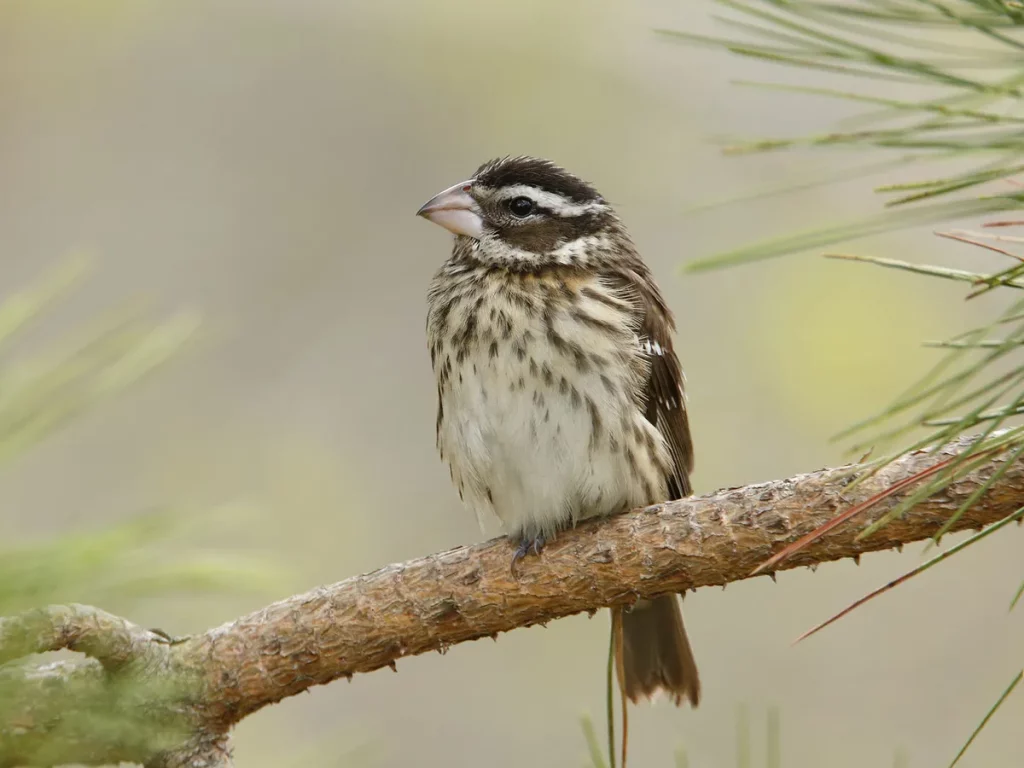
Rose-breasted Grosbeaks can be observed in Virginia during the summer breeding season, appearing in approximately 10% of summer checklists. They arrive in April and begin their migration in September.
Male Rose-breasted Grosbeaks have striking black and white plumage with a vibrant red patch on their breast. Females exhibit a more subdued appearance, with brownish and streaked plumage.
Scientific name: Pheucticus ludovicianus
Size: 7.1-8.3 inches (18-21 cm)
Weight: 1.6-1.9 ounces (45-53 g)
Wingspan: 11.8-13.4 inches (30-34 cm)
During the summer, Rose-breasted Grosbeaks breed across eastern and central North America. They primarily inhabit deciduous forests, wooded edges, and gardens.
Listen to the Rose-breasted Grosbeak’s song, characterized by a series of rich, robin-like warbles.
Their nests are cup-shaped structures, usually built on horizontal branches of trees. Constructed by the female, the nests are made of twigs, grasses, and plant fibers, and are lined with finer materials. Clutches usually contain three to five eggs, with an incubation period of around two weeks.
To attract Rose-breasted Grosbeaks to your yard, provide suitable forested habitats with ample food sources, such as sunflower seeds and berries.
Interesting fact: Male Rose-breasted Grosbeaks have one of the most melodious songs among North American birds.
26. Painted Bunting
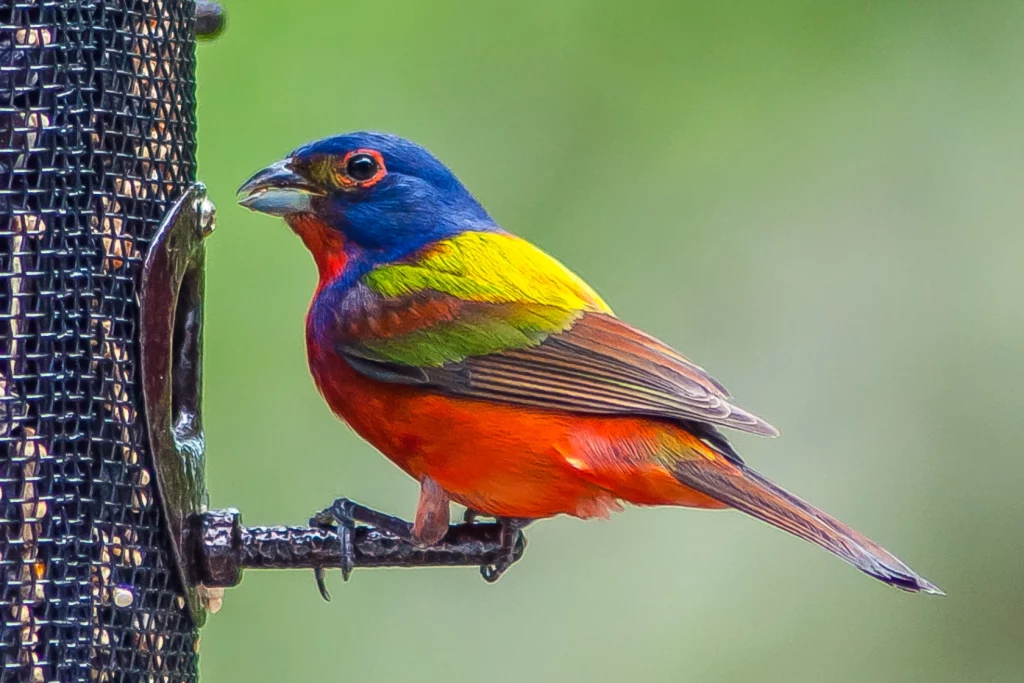
Painted Buntings can be spotted in Virginia during migration, appearing in approximately 2% of checklists during this time. They are typically seen from April to May and from August to September.
Male Painted Buntings are known for their vibrant and varied plumage, with a combination of blue, green, and red feathers. Females exhibit a more subdued appearance, with greenish plumage.
Scientific name: Passerina ciris
Size: 4.7-5.5 inches (12-14 cm)
Weight: 0.5-0.6 ounces (15-17 g)
Wingspan: 7.1-7.5 inches (18-19 cm)
During migration, Painted Buntings pass through Virginia while traveling between their wintering grounds in Mexico and their breeding grounds in the southeastern United States. They inhabit shrubby habitats, including fields, brushy areas, and gardens.
Listen to the Painted Bunting’s song, characterized by a series of sweet, musical, and often jumbled notes.
Their nests are cup-shaped structures, typically built in dense vegetation or shrubs. Constructed by the female, the nests are made of grasses, leaves, and plant fibers, and are lined with finer materials. Clutches usually contain three to four eggs, with an incubation period of around two weeks.
Since Painted Buntings are primarily observed during migration in Virginia, providing suitable shrubby habitats with ample food sources can attract them.
Interesting fact: Male Painted Buntings undergo a molt each year, changing their plumage from vibrant breeding colors to a more subdued appearance during the winter.
27. Western Kingbird
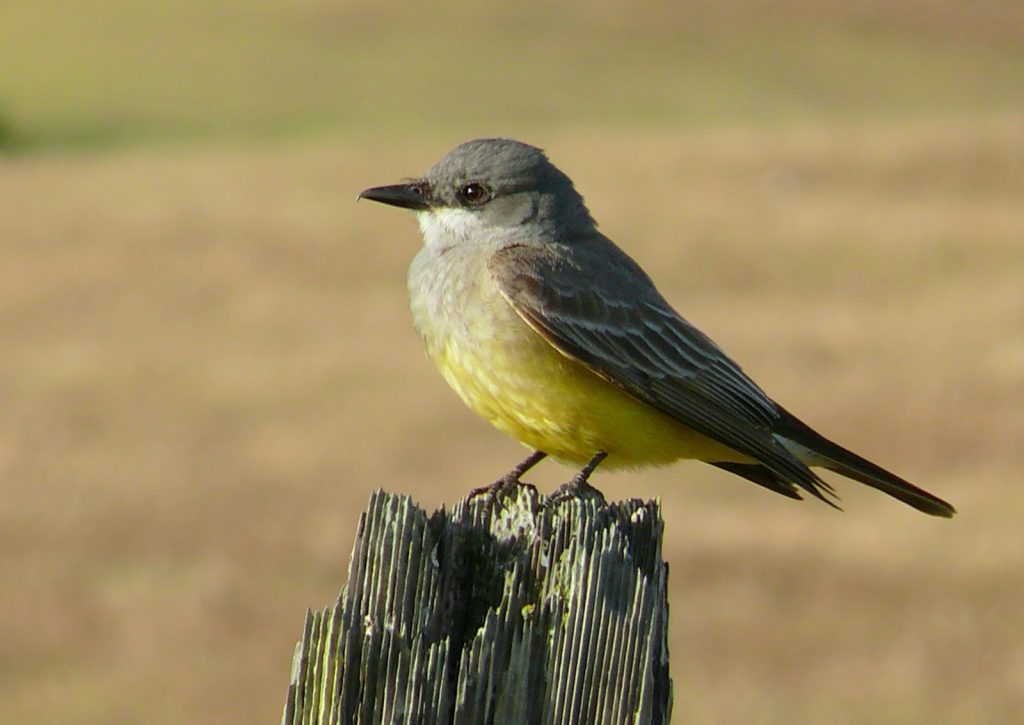
Western Kingbirds can be observed in Virginia during migration, appearing in approximately 2% of checklists during this time. They are typically seen from April to May and from August to September.
Western Kingbirds have grayish upperparts, pale underparts, and a distinctive yellow belly. They also have a white throat and a black tail with white outer feathers.
Scientific name: Tyrannus verticalis
Size: 7.5-8.7 inches (19-22 cm)
Weight: 1.1-1.6 ounces (30-45 g)
Wingspan: 13.4-14.6 inches (34-37 cm)
During migration, Western Kingbirds pass through Virginia while traveling between their wintering grounds in Mexico and their breeding grounds in western North America. They inhabit open habitats, including fields, meadows, and open woodlands.
Listen to the Western Kingbird’s song, characterized by a series of sharp, raspy, and descending notes.
Their nests are cup-shaped structures, usually built on horizontal branches of trees or on utility poles. Constructed by the pair, the nests are made of grasses, plant fibers, and feathers. Clutches usually contain three to five eggs, with an incubation period of around two weeks.
Since Western Kingbirds are primarily observed during migration in Virginia, providing open habitats with suitable perches for hunting can attract them.
Interesting fact: Western Kingbirds are known for their aggressive behavior, often engaging in aerial displays and chasing away larger birds from their nesting territories.
28. Yellow-headed Blackbird
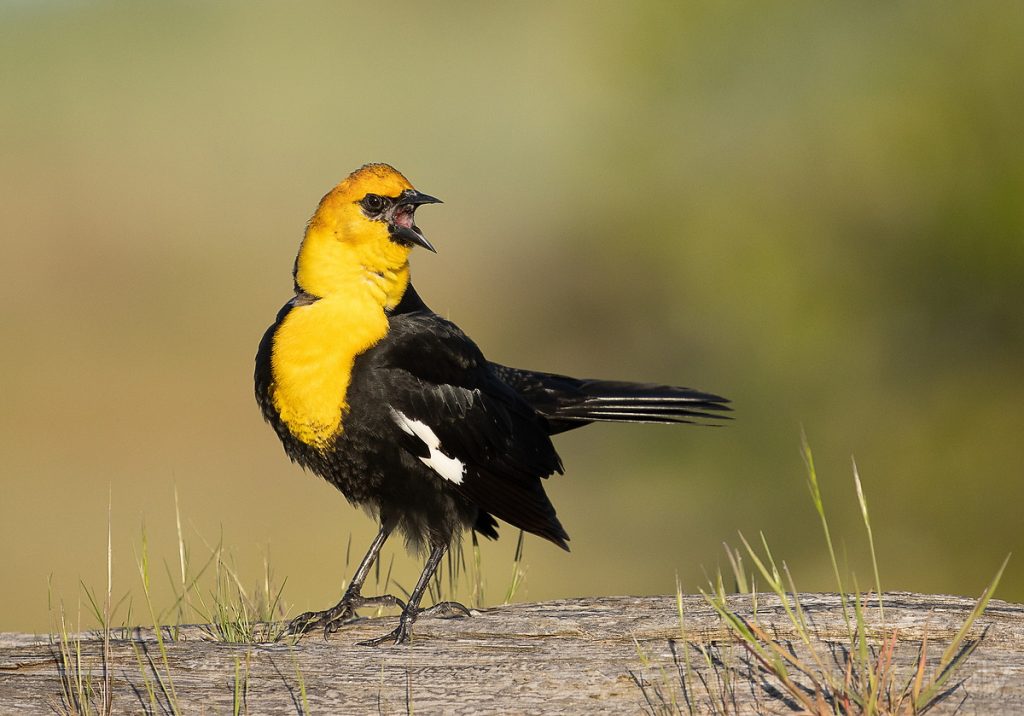
Yellow-headed Blackbirds can be spotted in Virginia during migration, appearing in approximately 2% of checklists during this time. They are typically seen from April to May and from August to September.
Male Yellow-headed Blackbirds have striking black plumage with a bright yellow head and breast. Females exhibit a more subdued appearance, with brownish and streaked plumage.
Scientific name: Xanthocephalus xanthocephalus
Size: 9.8-11.0 inches (25-28 cm)
Weight: 2.4-3.7 ounces (68-105 g)
Wingspan: 14.2-16.1 inches (36-41 cm)
During migration, Yellow-headed Blackbirds pass through Virginia while traveling between their wintering grounds in Mexico and their breeding grounds in western North America. They inhabit wetland areas, including marshes, prairies, and open fields.
Listen to the Yellow-headed Blackbird’s song, characterized by a series of raspy and guttural notes.
Their nests are cup-shaped structures, typically built in dense vegetation or cattails near water sources. Constructed by the female, the nests are made of grasses, sedges, and plant fibers, and are lined with finer materials. Clutches usually contain three to five eggs, with an incubation period of around two weeks.
Since Yellow-headed Blackbirds are primarily observed during migration in Virginia, providing suitable wetland habitats with ample food sources can attract them.
Interesting fact: Male Yellow-headed Blackbirds are highly territorial and will fiercely defend their nesting territories, often engaging in aggressive displays and vocalizations.
29. Palm Warbler

Palm Warblers can be spotted in Virginia during migration, appearing in approximately 8% of checklists during this time. They are typically seen from March to May and from September to October.
Palm Warblers display brownish-olive upperparts, yellow underparts, and distinctive rusty-colored caps. They also have bold black eye lines and white wingbars.
Scientific name: Setophaga palmarum
Size: 4.7-5.1 inches (12-13 cm)
Weight: 0.3-0.4 ounces (8-11 g)
Wingspan: 7.1-7.5 inches (18-19 cm)
During migration, Palm Warblers pass through Virginia while traveling from their wintering grounds in the southeastern United States and the Caribbean to their breeding grounds in northern Canada. They inhabit a variety of habitats, including open woodlands, shrubby areas, and marshes.
Listen to the Palm Warbler’s song, characterized by a series of high-pitched, trilling notes.
Their nests are cup-shaped structures, usually built on or near the ground in dense vegetation. Constructed by the female, the nests are made of grasses, leaves, and plant fibers, and are lined with fine materials. Clutches usually contain four to five eggs, with an incubation period of around two weeks.
Since Palm Warblers are primarily observed during migration in Virginia, providing suitable habitat with diverse vegetation can attract them.
Interesting fact: Palm Warblers are known for their “tail-wagging” behavior, where they constantly flick their tails up and down while foraging on the ground.
30. Magnolia Warbler
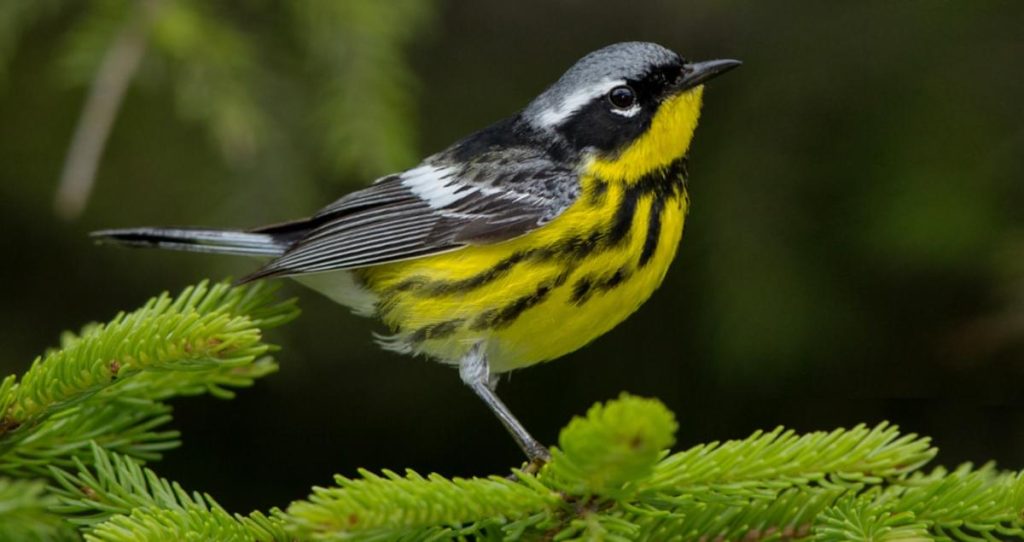
Magnolia Warblers can be observed in Virginia during migration, appearing in approximately 4% of checklists during this time. They are typically seen from April to May and from September to October.
Magnolia Warblers have black crowns, yellow underparts with bold black streaks, and white wingbars. Males also display a black necklace-like band across their yellow throats.
Scientific name: Setophaga magnolia
Size: 4.7-5.5 inches (12-14 cm)
Weight: 0.3-0.4 ounces (9-11 g)
Wingspan: 7.5-8.7 inches (19-22 cm)
During migration, Magnolia Warblers pass through Virginia while traveling between their wintering grounds in Central America and their breeding grounds in Canada and the northeastern United States. They inhabit various forested habitats, including deciduous and coniferous forests.
Listen to the Magnolia Warbler’s song, characterized by a series of high-pitched, buzzy notes.
Their nests are cup-shaped structures, typically built on or near the ground in dense vegetation. Constructed by the female, the nests are made of grasses, plant fibers, and fine materials. Clutches usually contain four to five eggs, with an incubation period of around two weeks.
Since Magnolia Warblers are primarily observed during migration in Virginia, providing suitable forested habitats with ample food sources can attract them.
Interesting fact: Despite its name, the Magnolia Warbler does not have a strong association with magnolia trees. Its name derives from the resemblance of its yellow underparts to the color of magnolia flowers.
31. Cape May Warbler

Cape May Warblers can be spotted in Virginia during migration, appearing in approximately 2% of checklists during this time. They are typically seen from April to May and from September to October.
Cape May Warblers have olive-green upperparts, yellow underparts with distinctive reddish-brown streaks, and a bold yellow collar. Males also display chestnut cheek patches.
Scientific name: Setophaga tigrina
Size: 4.7-5.5 inches (12-14 cm)
Weight: 0.3-0.4 ounces (9-11 g)
Wingspan: 7.5-8.7 inches (19-22 cm)
During migration, Cape May Warblers pass through Virginia while traveling between their wintering grounds in the Caribbean and their breeding grounds in Canada and the northeastern United States. They inhabit various forested habitats, including coniferous and mixed forests.
Listen to the Cape May Warbler’s song, characterized by a series of high-pitched, buzzing notes.
Their nests are cup-shaped structures, typically built on or near the ground in dense vegetation. Constructed by the female, the nests are made of grasses, plant fibers, and fine materials. Clutches usually contain three to five eggs, with an incubation period of around two weeks.
Since Cape May Warblers are primarily observed during migration in Virginia, providing suitable forested habitats with ample food sources can attract them.
Interesting fact: Cape May Warblers have a unique feeding behavior, as they often extract nectar from flowers using their specialized tubular tongue.
32. Nashville Warbler
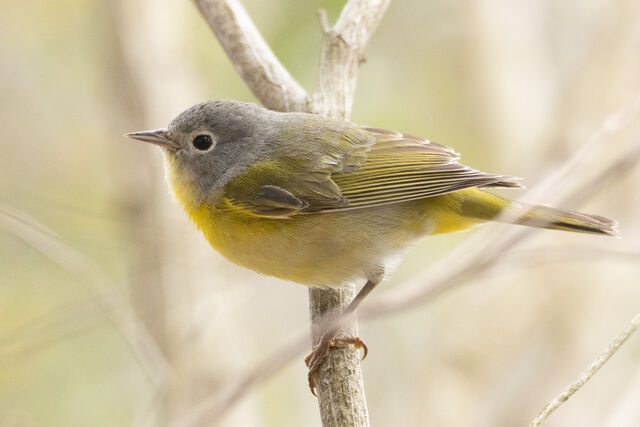
Nashville Warblers can be observed in Virginia during migration, appearing in approximately 4% of checklists during this time. They are typically seen from April to May and from September to October.
Nashville Warblers have olive-green upperparts, yellow underparts, and a distinctive gray head with a white eye ring. They also display white wingbars.
Scientific name: Leiothlypis ruficapilla
Size: 4.3-4.7 inches (11-12 cm)
Weight: 0.3-0.4 ounces (9-11 g)
Wingspan: 6.7-7.5 inches (17-19 cm)
During migration, Nashville Warblers pass through Virginia while traveling between their wintering grounds in Central America and their breeding grounds in Canada and the northeastern United States. They inhabit various forested habitats, including deciduous and mixed forests.
Listen to the Nashville Warbler’s song, characterized by a series of high-pitched, buzzing notes.
Their nests are cup-shaped structures, typically built on or near the ground in dense vegetation. Constructed by the female, the nests are made of grasses, plant fibers, and fine materials. Clutches usually contain four to five eggs, with an incubation period of around two weeks.
Since Nashville Warblers are primarily observed during migration in Virginia, providing suitable forested habitats with ample food sources can attract them.
Interesting fact: The Nashville Warbler was named after Nashville, Tennessee, where the species was first observed and collected.
These 32 yellow birds in Virginia provide a vibrant display of colors and songs throughout the year, showcasing the diversity of avian life in the state. Whether you spot them during their breeding season, migration, or year-round, these yellow birds add beauty and excitement to Virginia’s natural surroundings.
